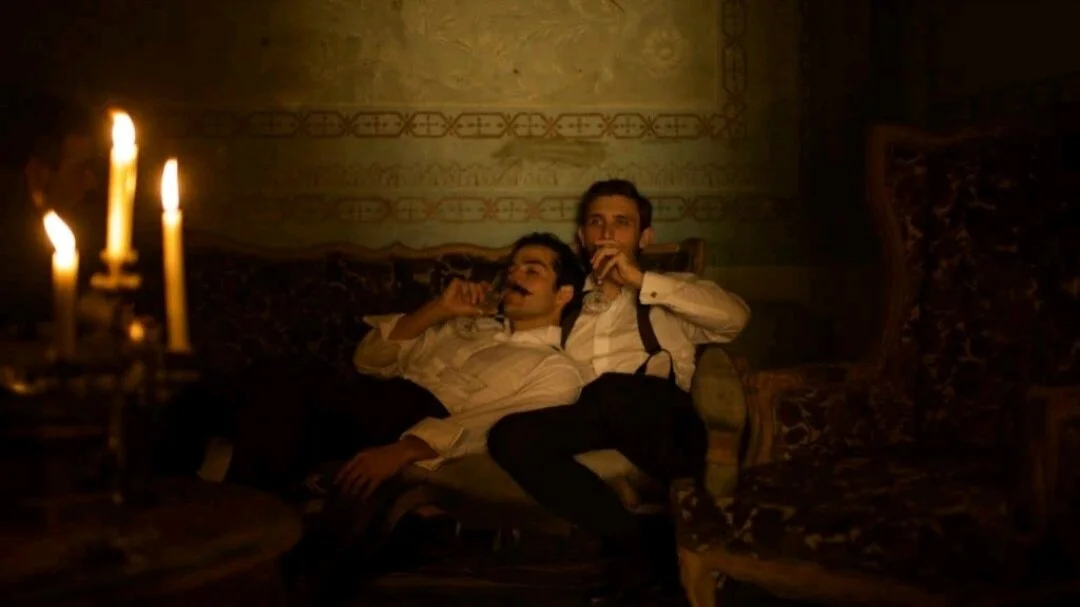DANCE OF THE 41
Directing: A-
Acting: A-
Writing: A
Cinematography: B+
Editing: B+
I sure wish it were easier to find out how Dance of the 41 (title in original Spanish: El Baile de los 41) is being received in its native Mexico. Perhaps this will change slightly over time, but at the moment I can find only one review written in English, and I am no longer fluent enough in Spanish to read the few reviews I have found in Spanish. There is no page for this film at MecaCritic.com, although over on RottenTomatoes.com it has a “fresh rating” of 75%, based on all of four reviews collected. (Actually all it’s officially showing is the user rating of 73%, the four critic reviews not enough in number to warrant an official “tomatometer” rating.)
I am here to tell you, though: this is a movie that commands attention. It deserves to be seen, and you should watch it. It’s streaming on Netflix, giving it a platform it could get few other places, so what excuse do you have? It does center around a 1901 event that became an enduring flash point in the history of queer people in Mexico, which, let’s face it, inevitably means it does not end well. You might want to brace yourself for the emotional gut-punch of the very last shot, in fact. You should still watch it.
The inevitably sad fate of the people involved notwithstanding, there is a lot to love about Dance of the 41. On a superficial level, the costuming and production design are impeccable; this is a visually lush period piece. I can’t imagine a huge amount of money was spent on this film’s production, but nothing that made it onscreen looks cheap. In fact, director David Pablos was granted access to Mexico City’s Casa Rivas Mercado for filming, a cultural center featuring the late 19th century architecture of the time.
There’s some pretty frank and occasionally explicit sex in this movie, both straight and gay—with quite a lot of male nudity. I say this not to be salacious, which this film really isn’t. When the Mexican president’s son-in-law, Ignacio de la Torre (Alfonso Herrera) introduces Evaristo (Emiliano Zurita) to the secret gay society to which he belongs, we eventually discover that they gather not just for high-society socializing, schmoozing and drinking and playing billiards, but also for orgies. What I love about how Pablos frames this is that it is always without judgment. Whether it’s a bunch of gay men sucking and fucking in a large room with a bunch of bathtubs, or an incredibly tender love scene between Ignacio and Evaristo alone in a bedroom, all Pablos seems interested in is showcasing queer joy. This applies to far more than just the sex; a key element of the historical event when one of these society parties gets raided by the police—in a man’s private home—is that half of them were dressed in drag. And until the raid, we just see a group of people being free to be their authentic selves, and it’s a beautiful thing.
The flip side, then, is the relationship between Ignacio and his wife, Amada (an excellent Mabel Cadena)—then-Mexican president Porfirio Díaz’s daughter. In an early scene, we see these two having sex for the first time on their wedding night, and it is one of the most awkward sex scenes I have ever seen committed to film. It’s rare we see this kind of scene, and I found myself thinking about how common it must have been in real life throughout history (and for some people, still is), for the poor women who marry men who are incapable of desiring them sexually. Given how easily this can breed (so to speak) resentment in such women, I think it will be easy for some to think of Amada as a villain here. It’s an easy trap that should be resisted, as it’s much more nuanced than that. I found myself sympathizing with Amada every bit as much as I did Ignacio.
Dance of the 41 takes a fascinating, contextualized look at a horrible moment in Mexican history—which I only learned about for the first time about a month ago, on TikTok. It’s apparently the reason many Mexicans have a negative association with the number 41 (and 42), with many in contemporary queer culture reclaiming them. This film, however, says little to nothing about the lasting cultural impact of the event, and focuses instead on the event itself, humanizing the people involved. Ignacio de la Torre was a real historical figure and rumored to have been at the event; it was always 42 people there, but the president, clearly wanting to avoid any association with it, had his son-in-law removed from persecution.
There is a brief sequence in the film depicting the horrible public humiliation endured by the other 41 people at the event, and it is indeed difficult to watch. Thankfully, Pablos neither dwells on it nor sensationalizes it, although he does allow enough time to challenge the viewers with the horror of it, which is only right and proper. Still, what sticks in your mind once the film is over, gut wrenching as the parting shot might be, is the far greater amount of time spent on the drama and romance leading up to it. In effect, most of this story is a love triangle, between two gay men and the wife of one of them. I really can’t recommend it enough, and really hope that word spreads that it’s worth seeing.
A lovely showcase for queer joy … until it isn’t: either way, a must-see.
Overall: A-

